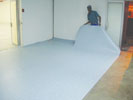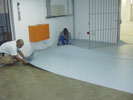

Many people do not know the difference between static dissipative and static conductive flooring.
In order to understand what makes these two floor coverings different, one needs to first understand what they are designed to do, and why.
The human body can generate up to 30 000 Volts in static electricity depending on the type of clothing we wear, the type of upholstery we sit on or floor coverings we walk on. The resulting discharge from the electron imbalance when we touch a grounding source is often felt as a static shock when touching another object. This energy discharge is problematic when working with flammable gasses or sensitive electronic equipment, and the static charge needs to be dissipated via ESD floor coverings or other ESD products, in a controlled manner in order to avoid damage to equipment or people.
ESD flooring is an excellent form of facilitating a uniform flow of static electricity directly to a ground point. Most types of vinyl flooring claim to be anti-static. This means that they do not contribute towards the build-up of static electricity in the human body. They also do not drain the static charge already built up. High levels of static are generated in dry areas, and conditions are much worse inland away from the coast.
The international norm for an electrically conductive floor covering is that it should have a resistance to earth level of between 104 and 106 Ω and an electrically dissipative floor should be between 106 and 109 Ω. It stands to reason that the electrically conductive floor covering will drain the static charge more quickly than an electrically dissipative floor covering as it has lower resistance to earth.

So what is the difference?
Static dissipative (SD) floor coverings are chemically treated to discharge static electricity and must be used in a controlled environment with a relative humidity of above 40%. Typical areas of use would be operating theatres, computer areas and instrument control rooms.
Electrostatic conductive (EC) floor coverings contain carbon and discharge static electricity more quickly and can be used in less controlled environments. In controlled environments they would be used in sensitive electrical and assembly areas as well as explosive manufacturing areas.
Electrostatic conductive and dissipative floor coverings are usually laid on a cement subfloor. Concrete is a poor conductor of electricity, so this type of floor covering needs to be laid using a conductive adhesive and earthed in order to drain the discharge. Aluminium or copper tape is laid in the adhesive under the floor covering and taken to an earth point. Two earth points are used in case one fails. For larger areas one earth point is allowed for every 20 m².
The floor coverings are available in both sheet and tile form. The tile sizes are 608 x 608 mm in order to accommodate raised access floors. Raised access floors are usually made of steel, to ensure that the legs are earthed. As a rule, electrostatic dissipative floor coverings are never sealed, as this would create a barrier between the floor covering and the human body and so prevent discharge. Conductive sealers are available if required.
Actum Electronics offers a comprehensive range of static control solutions and can be enlisted in order to do an audit of premises prior to specification, installation, testing and certification. The company has partnered with flooring experts Polyflor for all ESD flooring requirements. ESD flooring clients include Vodacom, Nissan, Grintek Ewation, Nokia, Armscor, MTN, Motorola, SAAB Technology, Denel and Mecer, amongst others.
| Tel: | +27 11 608 3001 |
| Email: | [email protected] |
| www: | www.actum.co.za |
| Articles: | More information and articles about Actum |

© Technews Publishing (Pty) Ltd | All Rights Reserved